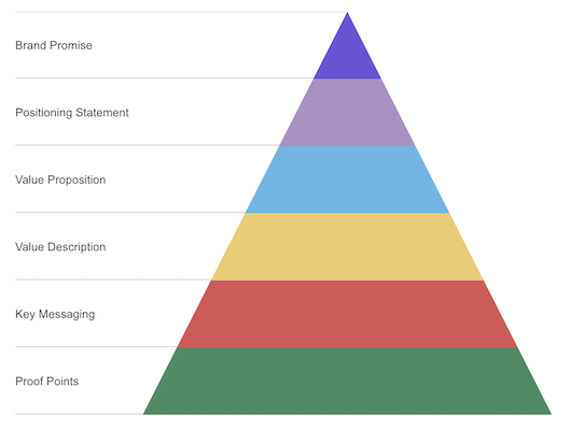In the battle against competitors for sales, a positioning statement gives brand stakeholders much-needed ammunition. Across marketing and sales channels, you need to know how to promote your product in a way that differentiates it from the field.
But a positioning statement is just the tip of the iceberg. Ideally, you’d have a one-size-fits-all solution to communicate your value prop to all segments of your audience.
But our customer bases are more complex than that. What speaks to one audience segment may not speak to another; what speaks to one individual prospect may not speak to another.
Enter: your messaging hierarchy. Establishing a messaging hierarchy gives brands a tiered, targeted set of language by which to communicate value — both in different media and to different audience segments.
Let’s take a closer look.
Elevate your product marketing strategy with this free kit >>
What is a messaging hierarchy?
Think about your marketing funnel. The funnel exists to ferry new prospects to your sales team — from the very early stages of brand recognition, to content consumption, nurture, product demo, etc.
A messaging hierarchy takes that same model and adapts it. The purpose of the messaging hierarchy is two-fold:
- To create a layered system of language that distills your brand’s value down to its essential points.
- To adapt that system to your various audience segments, or buyer personas.
Here’s what that looks like:

This is, in every sense, a fluid model. There’s no hard and fast rule that says the above image can’t be inverted to more resemble a traditional funnel. You also can and should play around with the messaging that exists at each stage to find the combination that works for your brand.
For our purposes, we find it helpful to flip the above model on its head, and to indeed think of this more like a traditional funnel. Starting broad gives you the ability to crowdsource messaging that appeals to a wide variety of use cases, and then refine throughout the model as you work toward your positioning statement and brand promise.
Let’s walk through each one of these stages and discuss their respective roles in the messaging hierarchy.
Stage 1: Proof points
Your proof points are the elements of your brand or product that separate you from the marketplace. These are the fundamental underpinnings of your product.
Coming up with proof points should be easy enough, right? You would not have launched your product if you didn’t think it had something to offer that the rest of the landscape did not.
Here’s the catch: Your proof points have to be undeniable. They have to be facts. As such, coming up with proof points can be one of the most difficult parts of the messaging hierarchy — because you have to look really honestly at your product and assess how functionally it solves your customers’ pain points.
Is it truly the easiest product to use, or is that just marketing? Is it truly the most cost-effective, or do you fill the sales process with fees to pad your margin?
Marketing for marketing’s sake is fine, but when you’re scoping out your proof points, you want to steer clear of the features and benefits that may be accurate. Doing so will allow you to speak to the most compelling benefits of the product when you ultimately leverage your messaging hierarchy for marketing.
That’s said, don’t limit yourself. It’s OK to go as broad as you can make a compelling case for — you’ll need it when refining at later stages of the hierarchy.
Stage 2: Key messaging
The key messaging component of your hierarchy — you could also call it simply brand messaging — drills downs on your proof points. If your proof points exist as a broad range of bullets, your key messaging should begin to distill those bullets into short, descriptive phrases that flesh out your product’s value in clear terms.
There are a number of ways this could manifest itself. From the proof point Most affordable, your key message could become More effective than [competitor] at half the cost. From the proof point Makes [process] easier, your key message could be Allows customers to complete [process] in 5 minutes or less.
Your key messaging doesn’t have to come out of your proof points. But they make great foundational bullets to build on. And again, just because you’re getting down to the essential benefits of the brand/product, doesn’t mean you should limit yourself. Come up with a diverse range of messaging here, keeping in mind that you will need an abundance of it to communicate value in your email campaigns, advertising, website copy, content marketing, and customer marketing.
Stage 3: Value proposition
The example diagram we first presented in this post differentiates the value proposition from the value description. If done correctly, though, you should have more than enough material from the first two stages of our messaging hierarchy to undertake your value proposition.
Your value proposition should be a complete sentence. You can have a single value proposition, but it makes more sense to have multiple value propositions that speak to each of your buyer personas (more on this shortly). If you have multiple products, you can have one or multiple value propositions for each; ditto for your brand itself. Either way, the goal is to collect the most essential elements of your key messaging statements, and leverage them to craft clear statements that define your product’s value.
It’s important here to speak directly to your personas. Don’t hesitate to show them that you know exactly who they are, what their pain points are, and how your product can help assuage those pain points.
Stage 4. Positioning statement
We’ve arrived at the penultimate stage of the messaging hierarchy — the positioning statement. The positioning statement is similar to the value proposition, but it’s not going to be as broad. You’re still speaking to your buyer personas, but now you’re paying particular attention to your competition.
The positioning statement is less about mere messaging than differentiation. While in your value proposition you may have spoken to a number of benefits that your customers should expect, your positioning statement should zero in on the precise ways those benefits separate your product from the rest of the field.
In all other stages of the messaging hierarchy, competitive intelligence should inspire how you communicate your brand’s value. But you may still find yourself communicating overlapping benefits, and that’s OK.
It’s the job of the positioning statement to promote your brand’s “uncommon” features — the characteristics you possess that the competition just can’t match. Consider leveraging battlecards here (and throughout this entire process) to more effectively zero in on these elements.
Stage 5: Brand promise
Your brand promise is simple and memorable. It distills all of the earlier stages of the messaging hierarchy into a single statement. It is the most refined of all stages, because it describes the experience your customer should expect to have every time they interact with your brand.
What’s the one common benefit or characteristic of your brand that all your customers experience? What’s the overwhelming impression they are left with? That is your brand promise.
Adapting your messaging hierarchy to buyer personas
We talked at the beginning of this post about the two most important functions of the messaging hierarchy. To repeat, they are:
- To create a layered system of language that distills your brand’s value down to its essential points.
- To adapt that system to your various audience segments, or buyer personas.
We’ve also talked about use cases where it would make sense to create messaging hierarchies for multiple products. Let’s expound a bit on the notion of designating unique messaging hierarchies for your personas.
Depending upon how pivotal your personas are to the process of marketing and selling your product (maybe they’re not overly pivotal), you may find it sufficient to keep them in the back of your mind while crafting messaging at each step of a single hierarchy. If you want to get really targeted in your approach, though, you’ll craft messaging hierarchies for each of your buyer personas. This is where it gets interesting.
If you’ve created personas, you know that each is characterized by its own unique set of pain points. Likewise, there are features of your product or service that pertain more meaningfully to each.
If you find yourself equipped with this intimate understanding of your audience segments, you should have no problem crafting, for instance, multiple value propositions that appeal to each segment. And not only should you be able to, but you’ll give your marketing and sales teams far more of a targeted script to work with when they are writing content, writing ad copy, talking to prospects, and closing deals.
Messaging hierarchies & competitive intelligence
We’ve mentioned the utility of competitive intelligence when it comes to creating an effective messaging hierarchy. While the positioning statement and brand promise are perhaps the two most important stages to consider your unique differentiator, each layer of your messaging — from your proof points, to your key messaging, to your value proposition — can and should derive from an intimate understanding of your competition.
Crayon can help. From our free guides and templates, to our case studies and thought leadership: We give businesses the tools they need to understand their competitors like they understand themselves. Try our free competitive landscape report, or check out one of our case studies to see how Crayon helps brands everywhere establish winning market positions.

Seeing is believing! Check out Crayon for yourself.
Take a Product TourRelated Blog Posts
Popular Posts
-
 The 8 Free Market Research Tools and Resources You Need to Know
The 8 Free Market Research Tools and Resources You Need to Know
-
 6 Competitive Advantage Examples From the Real World
6 Competitive Advantage Examples From the Real World
-
 How to Create a Competitive Matrix (Step-by-Step Guide With Examples + Free Templates)
How to Create a Competitive Matrix (Step-by-Step Guide With Examples + Free Templates)
-
 24 Questions to Consider for Your Next SWOT Analysis
24 Questions to Consider for Your Next SWOT Analysis
-
 How to Measure Product Launch Success: 12 KPIs You Should Be Tracking
How to Measure Product Launch Success: 12 KPIs You Should Be Tracking



